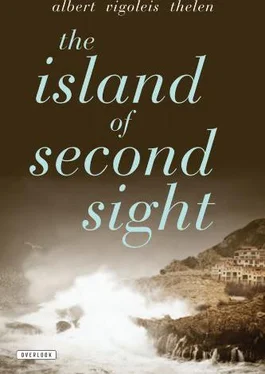Anyone observing these nocturnal goings-on would have to conclude that a palace was being plundered by a mob. Down with feudal domination! To the gallows with the princes, counts, and barons! Death to the Suredas! Afterwards it was determined that plundering had in fact taken place, although the items stolen were among those that the master of the palace had designated as unimportant: the treasures of the Kings of Aragón and Mallorca. To him, the most valuable property was the chairs that had been sat upon by celebrities, the cups from which they had sipped their coffee, the mattresses they had lain upon either alone or in company of others.
When the embargador arrived the next day, he found the site empty and deserted. Apart from a lone chair, he could identify nothing fit to be auctioned. He had to settle for the immoveable parts of the estate, the buildings and grounds. And when he sat down on the single remaining chair — now a prop in a tragedy different from the one Vigoleis was living through — with the intention of writing down his official report, he ended up flat on the ground. The chair had only three legs. With this gesture, the civil servant brought to completion all that the now-defunct charterhouse had to offer.
Don Juan escaped to the hills, his children resumed their marauding, and the Princess continued painting. The three-legged chair did not wander off with a special tag to the arsenal on Bitterness Street. Instead, Don Juan remained true to his custom and had it taken to Palma, where relatives of his had meanwhile rented an apartment. Life went on. Now the family was “tenement nobility,” and the three-legged chair represented their best effort at displaying high style. Was there a shedding of tears? Spanish grandees don’t cry over minor matters.
“Wait, Beatriz. I’ll go get a ladder next door. They’re always willing to lend us one when we have company. Then you can get that topmost mattress ready. It’s the one that was slept on by Don Ramón del Valle-Inclán. I know you’re not much of a fan of that writer, but it’ll be hard to haul anything else up there to sleep on that would be more to your liking. Let’s just see…”
This mountain of a bed, consisting in layer upon layer of mattresses, bore tags that exhibited the following strata of famous slumberers: Don Gabriel Alomar — Don Felix Rubén Darío — Don Miguel de Unamuno — S. A. R. Luis Salvador — Don Federico Chopin — Jovellanos — Mother Ey — Don José Miralles — Archbishop Obispo — Don Antonio Gelabert — Azorín — Don Ramón del Valle-Inclán. I would have liked to lie on top of my fellow-countrywoman Mother Ey, about whom Pedro told us some fascinating tales, whereas Beatrice announced a preference for Chopin. But rearrangement of the mattresses was as good as impossible without emptying out the whole room. So we decided to accept the stratification as it came about hastily during the wild night of enforced removal. And anyway, this mountain of mattresses had attained its size according to certain laws of destiny. For example, the one labeled “Alfonso XIII EL REY ” did not end up in our largely democratic heap of pallets.
One aristocratic trait in Mamú’s personality that I admired greatly was this: she couldn’t sleep in strange beds. She therefore took her own bed with her on her travels — or rather, she owned several such personal beds. She always sent one of these ahead together with her load of large baggage. Other people, on the other hand, are proud to be able to tell their grandchildren that they have slept in beds in which kings, popes, celebrated whores, saints, or dictators have sweated out their lust and their fear, their piety, hypocrisy, death agony, or contempt for the Divinity. Beatrice also doesn’t like strange beds, whereas I myself hover too insecurely between the earth and the sky to have much concern about the surface I sleep upon. On this evening in the Sureda panopticon, before climbing on top of the Valle-Inclán mattress, Beatrice took a sleeping powder, not for fear of any infra-poetic vapors emitted by that romantic libertine, but out of sheer terror that she might hit her head against the ceiling if our own body heat should cause the ghostly pile beneath us to come alive, much as fleas can be animated by the scent of human blood. I took no such precautionary measure, with the result that I received a bump on my forehead when the souls underneath us got restless, making me have vivid dreams about what each of them was going through as they slept on Sureda mattresses. Mr. Silberstern, who will make his appearance in a later chapter, would have hit the ceiling with his belly — that is how narrow the space was between Valle-Inclán and the beams of our ceiling.
Next to our sleeping quarters was a room full of chairs. Although the eviction from the castle had taken place two or three years previously, it was impossible to imagine how anybody could have piled up these hundreds of chairs in such a way as to avoid getting buried beneath a cascade of tumbling poltronas . The room was chock full. Not all of the chairs in this collection were catalogued. But every last one of them had, at one time or another, served as a place of repose for some notable personage — and who, in Spain, is not notable? Don Juan at first intended to put labels on the unidentified items, but then he decided against it for two reasons: he did not want anyone to accuse him of historical falsification, and he simply could not face the idea of returning to the Valley of the Muza. And besides, a sufficient number of chairs were already tagged with famous names in the interest of posterity.
In the presence of these thousands of chair legs, it once again became apparent how false and mean the suspicions of Mamú’s Christian ladies had been that Vigoleis was a Communist. For now he would have to be overcome with distress at the thought of his one single, borrowed chair. Here the chairs were struggling beneath their own weight, as well as under a heavier mythological burden. I felt not the slightest twinge of envy; I remained as cool as a historian registering facts, so long as they were certifiable as such. This, too, was a Waterloo, and that was all it was. It was difficult to reconstruct what had happened at the site.
Another room was reserved for the crates and baskets containing historical porcelain and flatware, as well as for the bedclothes, blankets, pillows, and bedspreads, all of them in bundles bearing labels. Most of this collection had already been consumed by moths or gnawed by mice and rats. I rummaged out several boxes filled with gold and silver livery buttons. When their shine suddenly faded and their heraldic symbolism disappeared, Don Juan removed these buttons with his own hands, but permitted his servants to keep their uniforms.
Dinner jackets, hats, ladies’ suits, children’s clothing — a theater wardrobe of astonishing variety lay in a pile beneath the staircase, covered with burlap. And in a special box, carefully packed in straw, the noble family’s chamber pots. Among these there was one worth mentioning, not for the personage who utilized it — a tag revealed the name attached to this most private of utensils — but for what was visible inside it. But let me quickly prevent any misunderstandings. In a later chapter a similar misunderstanding will prove absolutely crucial, but in the present instance I wish to draw attention solely to the decoration and inscription inside this ethnologically significant household item, to which we must give our attention anon.
Paintings by El Greco and Murillo; Italians, Dutch masters; incunabula, manuscripts, the entire palace library — Don Juan was unable to rescue a single item. One shudders at the thought of sardines being grilled and paella simmering on cottage hearths all over the Valley, over flames fueled by irreplaceable treasures of the nation’s past. And yet we ourselves, we who call ourselves representatives of the great Western cultural and intellectual tradition, we who boast of our command of the alphabet, who read books and perhaps even write them — were we any different from those Valldemosans who didn’t care a fig about frying their fish on a fire produced by a first edition of Quevedo?
Читать дальше












